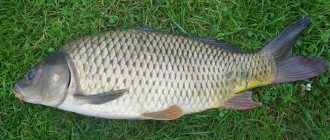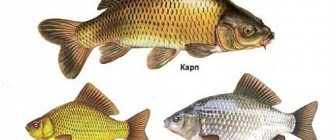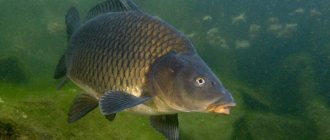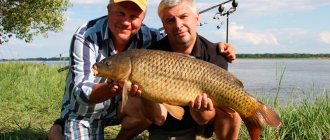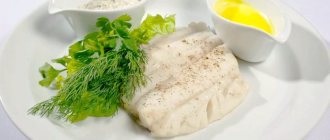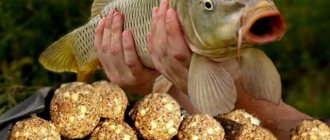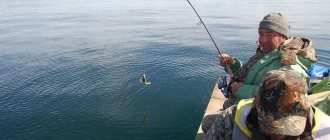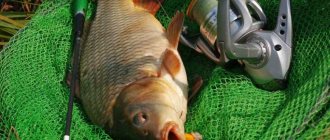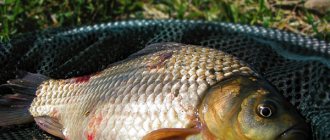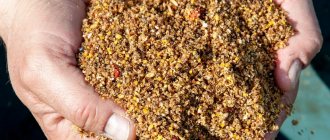Rod selection
When fishing for carp, all fishing rods are used - fly rods, Bolognese rods, match rods, and plug rods. Each of them is not universal, is intended for fishing in certain conditions and has its own advantages and disadvantages.
Flywheel
The fly rod is the lightest and most sensitive among the float rods.
Thanks to the lightweight absence of guide rings and a reel, this rod is widely used for coastal fishing for medium and small carp. The length of the fly forms ranges from 4 to 5-7 meters. Advantages:
- Ease and convenience to use;
- Ability to use thinner fishing line and equipment;
- Quick replacement of equipment;
Flaws:
- Inability to change the length of the fishing line when fishing for large carp;
- Inconveniences when fishing at a close distance, several times shorter than the length of the equipment;
- Casting limited by the length of the equipment;
- Inconveniences when using on the current;
Bologna
A Bologna rod or “bolonka” – unlike a fly rod, has guide rings and a reel, which allows you to adjust the length of the equipment.
On sale there are “lapdogs” ranging in length from 4 to 6-7 meters. This rod is used for catching carp from the shore and boat, with longer casts than the fly rod. Advantages:
- The casting range is several times greater compared to the swing;
- Ability to change the length of the main line;
- When fishing for large carp, a rod with guide rings and a spinning reel will allow you to evenly distribute the load on them when fishing;
Flaws:
- The weight of such rods is greater compared to their fly analogues;
- When using a thin fishing line, over time, it gradually abrades on the surface of the guide rings;
Match
A match rod (match) is a type of float rod for long and accurate casts. A flexible and durable fishing rod up to 4.5 meters long is equipped with a larger number of guide rings than a lapdog.
In carp fishing, particularly durable special plug-in carp matches are used for shore fishing up to 4.2 meters in length.
Advantages:
- The highest casting range among float rods;
- Strength and reliability of the form;
- Uniform distribution of the weight of the hooked fish over the entire form due to the large number of passage rings;
Flaws
Heavy weight – carp matches, compared to fly and Bolognese rods, as well as classic match rods, weigh significantly more due to the reinforced design
Plug
A plug rod is a tackle more suitable for sport fishing.
Due to their design, the casting range with plugs is greater than with a lapdog, but less than that of match rods. When fishing for carp, it is not used as widely as the three previous types - plug rods are high cost, require a large number of additional devices for fishing with them (retractable rollers, stands), are fragile and cannot be repaired independently. Thus, among the rods described above, the most suitable for carp fishing is a sensitive and light fly rod and a long-range match rod. The Bolognese fishing rod is used most often in the absence of the previous two, but the plug is not widely used mainly because of its high cost.
Carp rods
A standard carp match rod differs from others in its durable blank with a dough weight of up to 20-25 grams, reinforced guide rings, and a reliable and comfortable handle.
The following models can be distinguished from the specialized carp fishing rods used:
- Shimano VENGEANCE AX Specimen 13-350 DL 2PCS is a plug-in two-section rod with a length of 396 cm. Thanks to the use of XT30 carbon fiber in the blank, it perfectly dampens the jerks of even very large carp.
- Daiwa BLACK WIDOW CARP 360 is a two-section carbon fiber carp rod with a length of 360 cm. Reliable and quite light with a long, comfortable handle made of EVA polymer.
- Salmo Diamond CARP is a carp rod made of IM brand graphite consisting of three sections with a total length of 360 cm. The handle is spaced apart, made of neoprene.
Choosing bait and bait
Carp is considered a very finicky fish, which is not easy to please with bait and bait.
Therefore, when going fishing, the angler should have several options for bait, as well as bait mixtures. When fishing in spring, it is more effective to use animal baits:
- bloodworm;
- worm;
- maggot.
In summer, it is easier to tempt carp to bite with vegetable baits:
- canned corn and steamed peas;
- wheat and pearl barley;
- dough and boilies.
In autumn, both animal bait and vegetable baits are used to catch carp.
Often fish actively respond to sandwiches from different baits. A necessary condition when fishing for carp is feeding a promising place. Both store-bought formulations and homemade mixtures and porridges can be used as bait.
The most important condition for feeding is the presence of large particles in the bait:
- peas;
- corn;
- cereal grains;
- boilies;
- peles;
- worms
Only this kind of bait can attract and keep large fish at the fishing point.
An overview of all methods of carp fishing in the next article. What baits and baits are used, as well as types of equipment.
For carp fishing with a feeder, what the feeder attachment should be and other aspects, read this article.
Carp on a spring, the advantages and disadvantages of this method of catching large carp further.
Gear selection
Coil selection
For fishing with a match float rod, a mandatory element of the gear is a special carp spinning reel.
Such a coil must meet the following requirements:
- The material of the reel body is light and durable alloy;
- The shallow depth of the spool allows it to be completely filled with a large volume of thin monofilament fishing line;
- Reel size from 5000 according to Shimano classification;
- Parts of the spool drive mechanism must be made of metal or durable alloy;
- Gear ratio – for fishing you need power reels that make 4.2-4.6 turns of the spool per turn of the handle;
- At least 3-4 bearings must be installed in the handle and spool rotation mechanism;
- A prerequisite is the presence of a rear friction brake;
- Bearing in the line roller;
- Reinforced handle;
- Reliable baitrunner.
Top 3 rating of the best reels
The following models are recognized as the best reels today used in carp fishing with float tackle:
- Shimano Baitrunner XT 8000 RA;
- Daiwa Black Widow 3500-5000;
- Banax Helicon 500NF;
When fishing for carp with a Bolognese fishing rod, you can use small match spinning reels.
Line selection
When fishing, even a small carp strongly resists. This violent resistance, combined with the decent weight of the fish, dictates the need to use strong, but at the same time fairly thin and invisible fishing lines.
When fishing with match and Bolognese fishing rods, special sinking carp fishing lines with a cross-section from 0.2-0.22 to 0.3 mm are used; for a fly fishing rod - thinner ones with a cross-section of 0.18-0.2 mm.
The most popular brands of monofilament fishing line are:
- Shimano Blue Wing Line 100MT;
- Power Phantom Clear;
- Aqua PA Ultra Soft Match;
Hooks
Special hooks are used to catch carp
Their feature is:
- Strength – the carp hook should spring back, but not bend;
- Long forend;
- Very sharp, inwardly curved sting;
- Matte or black hook surface;
- The ring for the fishing line is bent inward;
The size of the hook is selected depending on the type of bait and the size of the carp living in the pond. For catching medium-sized carp, hooks Nos. 8-10 are sufficient; for large specimens, hooks Nos. 6-8 are sufficient.
Among the manufacturers most often used in carp fishing are hooks from:
- Korda;
- Fox;
- Gamakatsu;
Sinkers
The shape and weight of the sinker plays an important role in the rigging of a float rod.
- To increase sensitivity and reduce the noise produced by sinkers in contact with water, when casting, the entire load is divided into 2-3 parts.
- Lead pellets of different weights are suitable and convenient for light fly fishing rods.
- Such sinkers are secured by carefully clamping the fishing line in the slot made in them.
- For match gear, the main part of the load consists of the corresponding weight of the olive; the pellets are installed only at the leash
Float
When fishing for carp with a fly rod or Bolognese float rod, use floats with an elongated, spindle-shaped body, a long antenna, and a narrow keel. For fly tackle, take lighter and more sensitive floats with a load of up to 1.5-2 grams, while for “lapdog” take load-lifting alarms capable of holding a load of 2.5-3 grams.
Match tackle requires a special float for long casts - a waggler, which has a long thick antenna, a spindle-shaped body and its own weight in the form of washers fixed in place of the keel.
Leash
The use of a leash in float gear for carp fishing is mandatory. The length and cross-section of the fishing line depends on the type of gear used:
- When using a fly rod, the leash is made 15-20 cm long from thin fishing line with a cross-section of 0.15-0.16 mm.
- For match gear, a thicker leader line with a cross-section of up to 0.18 mm and a length of up to 40-50 cm is used.
How to increase your fish catch?
Over 7 years of active fishing, I have found dozens of ways to improve the bite. Here are the most effective ones:
- Bite activator . This pheromone additive attracts fish most strongly in cold and warm water. Discussion of the bite activator “Fish Hungry”.
- Increased gear sensitivity. Read the appropriate manuals for your specific type of gear.
- Pheromone -based lures .
Fishing technique
When a promising place for fishing has been found, it is necessary to cast the tackle, measure the depth, and mark the exact casting distance on the fishing line .
After feeding, you can cast the tackle with a nozzle and wait for the bite. Usually the carp tries the bait first, which can be seen by the float's antenna swinging.
If the bait does not cause suspicion in the fish, then a sharp bite follows. After hooking, the carp strongly resists and tries to move away from the shore. The precise operation of the clutch is important here. When you manage to tire the fish, you need to put it in a large landing net.
Float rod equipment
Blind equipment
Blind rigging is typical when using a fly rod.
It uses a thin and strong fishing line with a cross-section of up to 0.18-0.2 mm, a small and sensitive float loaded with pellets. The advantage of such gear is its sensitivity and stealth. The most significant disadvantage is the fixed length of the equipment, which cannot be quickly changed during the fishing process.
Sliding equipment
Sliding equipment is more active. It is used in carp fishing with Bolognese and match fishing rods. With this installation, the entire equipment can change its length using a reel and a rod equipped with rings. Unlike the blind one, it is rougher, but at the same time it makes it possible to make long casts, the magnitude of which is limited only by the supply of fishing line on the reel spool.
Loading the float
A properly loaded float will allow you to see even the most careful bite of a cautious carp.
On the fly and Bolognese fishing rods, the float is surrounded with lead pellets of varying weights or one olive. To increase sensitivity, the entire load is divided into:
- The main load is a set of pellets or an olive, located 20-25 cm above the place where the leash is attached to the main line.
- Sub-grazing is about 10-15% of the entire float load. It consists, like the main load, of pellets, but smaller ones weighing 0.1 grams, and is secured at the junction of the leash with the main fishing line.
Very often the main load is divided into several parts spaced 5-10 cm apart. Assembling such gear is not difficult.
The main load should submerge the float to the base of its antenna, while the underweight should regulate the height of the antenna tip protruding above the surface of the water.
Rough loading of the float is carried out at home - in a bathtub, barrel, bucket - securing the main load. The alarm is more finely tuned by selecting the weight of the graze directly on the reservoir. The degree of immersion of the antenna is adjusted depending on the fishing conditions:
- In case of strong wind, current, or wave, the antenna should be loaded no more than 1/3 of its length;
- In calm water conditions, for greater sensitivity, leave only half of the antenna above the water.
Bait for carp
Feeding is the key to successful fishing. In terms of efficiency, homemade baits are often not only not inferior, but even superior to store-bought ones. It is worth noting that bait for carp is extremely similar to bait for crucian carp. Some brands even produce bait for two types of fish at once.
Recipe No. 1
- 200-300 grams of crackers from black, not moldy bread, carefully crushed;
- Add 250-300 grams of milk powder and soy flour, 200 grams of egg powder to the resulting mass;
- Mix thoroughly until the mixture becomes a homogeneous granular mixture, adding 1 teaspoon each of fine salt and sugar;
- Mix with dry red clay;
- Before fishing, the bait is moistened to a thick viscous state;
Recipe No. 2
- Millet, pearl barley and semolina are placed in a large container and filled with water;
- Cook over low heat until each ingredient is completely cooked.
- Add a little unrefined vegetable oil, 2-3 tablespoons of honey, breadcrumbs, makukha (cake) to the resulting porridge.
- Let the bait sit and thicken
Watch the process of preparing bait online:
https://www.youtube.com/watch?v=mQuzmzLVJ4o
Purchased bait
Among the purchased baits for catching carp on a float, the following mixtures are popular:
- Dunaev Karp,
- RS Carp XXL,
- Traper Big Carp
Aromatization
Since carp are caught in warm water, the use of flavorings both as additives in bait and in the composition of the bait plays a huge role in the quantity and quality of the catch. To add an aroma that attracts fish, use:
- Anise;
- Vanilla;
- Honey;
- Garlic extract.
Typical flavorings for carp
Feeding process
- To feed carp, prepared bait in a bucket or other container is mixed with soil - pre-prepared clay, sand, or simply earth taken from the shore. After the soil has been distributed evenly between the bait particles, they begin to add water and just as thoroughly knead the resulting mass until it becomes thick. From the mixture, left for 5-10 minutes, 10-12 balls of different density with a diameter of 5-7 cm are molded.
- 3-4 balls are thrown into the fishing spot for starting feeding, two of them are tightly molded, and the rest are looser. This is done because denser balls will disintegrate slowly; although they will not attract fish immediately after casting, they will still hold them later. Balls that are looser will begin to collapse almost immediately when they hit the water, attracting fish to the fishing spot. This scheme will allow you to quickly attract the carp with a large portion of bait from the second balls and then keep them in a certain place for a long time from the gradually falling apart first ones.
- If the bite is weak, they resort to additional feeding - for this, the remaining balls are sent to the fishing point according to the same principle as during the starting feeding.
- In order to attract carp, you need to throw bait as accurately as possible to the place where you plan to fish. If the fishing distance is very large, then special slingshots are used for feeding, with the help of which the balls are not only thrown to the required distance, but also ensure high accuracy of their hits.
When feeding, do not forget about the bottom topography, in which too dense balls will roll deeper down.
Carp fishing line
We would like to present you an article about an important element of equipment for a car, when choosing which you need to know a lot and apply your knowledge. Probably the most valuable element of the tackle is considered to be a fishing line for carp fishing.
After all, it bears a considerable share of the load when casting and landing fish.
After analyzing many pages of their fishing forums, we were able to identify the main questions about fishing line, here they are:
- What fishing line should you buy for carp fishing?
- What diameter of fishing line is best to choose?
- How often should the fishing line be replaced?
In the article below we will try to provide comprehensive answers to anglers’ questions regarding fishing line.
How is carp fishing line classified?
The main classification of fishing line is made according to the materials from which it is made. There are the following types of materials from which carp fishing line is made:
Nylon - this material was invented by scientists from American laboratories in the 30-40s of the 20th century. It is one of the first materials obtained specifically for the manufacture of lines intended exclusively for fishing. Nylon - today is not in great demand among fishermen (it quickly breaks down under exposure to the sun and under heavy loads). According to historical sources, the Germans invented nylon in 1952-1953. Polyethylene - used for the production of braided types of fishing line, which are very popular among fishermen due to their low elongation and strength despite their small diameter. The materials used for production are different, but they differ only in the method and material for impregnation. Fluorocarbon - in 1971, the Chinese presented their creation to the world in the form of fluorocarbon. This material was intended for oil companies. The material is very resistant to chemical and physical stress. A fishing line made from such material will not change its properties in the temperature range from -40 to +150 degrees Celsius. This type of fishing line is difficult to “kill”; it is not affected in any way by exposure to the sun and physical activity.
It is also worth noting that it is invisible in the water due to the refractive index of light, which is very useful when catching wary fish such as carp.
Buying fishing line for carp fishing
The fishing line for carp should not wear out quickly, should be invisible against the background of the bottom and sink fairly quickly
Paying attention to the materials from which the fishing line is made, we can identify a clear leader in this segment - this is fluorocarbon fishing line. This material is 100% suitable for carp fishing.
Many people may notice the huge selection of fishing lines on the shelves of fishing stores. During a visit to the store, avid fishermen immediately have a lot of thoughts in their heads: What is better to buy? How much money to spend? Isn't it too expensive? And this list can be continued indefinitely
There is no need to resort to panic and you need to pull yourself together! Don't pay attention to other gear, rods and reels, concentrate on buying fishing line. Today you have one goal, one purchase - carp fishing line
First you need to identify one or more reliable brands that produce fishing line
Moreover, it doesn’t matter whether the fishing line is expensive or cheap, the main thing is that it can withstand heavy loads. If you can afford to buy expensive fishing line, then choosing a manufacturer will not be difficult; as a rule, they are all good
The main thing is to buy them in specialized stores, but not on the market. When buying fishing line on the market, they may sell you something that is not what you need. I recommend choosing from cheap fishing lines. She excels at fishing. It does not wear out like other inexpensive options and is quite reliable.
What diameter of fishing line is needed for carp fishing?
After reading the above recommendations, choosing a fishing line manufacturer that suits your budget will not be difficult. The next, no less important step is to decide on the diameter of the fishing line.
The fishing line for carp should be as strong as possible with a minimum diameter. Thanks to its small diameter, the fishing line allows you to cast the tackle over long distances and minimizes its detection by fish; these are the key stages when catching carp on a bottom. Read more in the article: Donka for carp. A high-quality fishing line allows you to pull out a carp that weighs much more than the stated breaking value. The Carp Expert mentioned above, with a breaking load of 7 kg, allows you to pull out a carp of 10 kg! Based on this, use a fishing line with a diameter of more than 0.3 mm. it won't be entirely correct.
Baits and attachments for carp fishing
Among the baits, carp prefers:
- Undercooked new potatoes;
- Canned or boiled corn;
- Boiled peas;
- Millet;
- Bread crumb;
- Pea mastyrka;
- Steamed grains of rye or wheat;
- Semolina chatter;
- Boyles
In addition to baits, especially in spring and closer to autumn, carp also take the following baits:
- Maggot;
- Dung and earthworm;
- Bark beetle;
- Shitik;
Technique for catching carp with a float rod
Choosing a fishing spot
Carp lives almost everywhere, populating reservoirs with both standing water and moderate currents. Carp prefers the deepest places with a hard clayey and slightly silted bottom, abundant in aquatic vegetation. Most of the day it stays at depth, at dawn and after sunset it enters shallow muddy bays to feed.
- In ponds, lakes and large reservoirs, to catch it, choose places with a depth of 2-3 meters near thickets of egg capsules, under tree branches overhanging the water, near a flooded snag.
- In rivers, carp are looked for in deep backwaters and creeks with thickets of reeds and cattails, on wide reaches with a moderate current.
Fishing in still water
Fishing for carp in reservoirs with stagnant water begins in late May - the first ten days of June, after the fish have spawned, and continues until mid-September.
In small bodies of water, as well as when fishing near the coastline, use a fly float rod with light equipment.
If you plan to catch carp in places remote from the shore, at a distance of more than 15-20 meters, match rods are used. Before fishing begins, the area is fed with bait balls. The main attachments are corn, steamed peas, mastyrka. A boat for carp fishing is used in cases where it is impossible to throw gear from the shore due to the fact that it is abundantly overgrown with reeds, bushes, trees, or the reservoir has become very shallow and the deepest places are in its middle.
In addition, the boat will be indispensable when fishing in the channel ditches of reservoirs remote from the shore, and on the edges of artificially dug wintering pits.
The most suitable tackle for fishing from a boat is a short fly rod or Bolognese rod. They feed both with the help of balls prepared on the shore, and with a feeder lowered at the fishing site.
Fishing on the current
On rivers, carp are most often caught in places with weak or moderate currents, in deep backwaters and oxbow lakes, in holes under steep banks bordering shallow waters. Carp does not like straight sections of rivers with a rocky bottom, devoid of coastal aquatic vegetation.
- Long Bolognese and match rods are used to catch river carp. Fly tackle is used when fishing in backwaters and old fish.
- Feeding is done with the most dense balls that wash out in water for a long time.
- Along with vegetable baits, river carp take shells well for meat.
Fishing in muddy water
Changing the transparency of the water in a river, lake, or reservoir significantly improves the carp's bite - in such an environment the fish are less timid; due to the turbidity, they cannot see as well as in clear water. At this time, the carp more confidently approaches the shore and rises to mid-water.
Fishing depending on the bottom and soil
Carp is a fish that prefers to stay near the bottom most of the day. This feature leaves its mark when fishing for it in places with bottoms of different composition and topography.
So, in reservoirs where there is enough silt at the bottom and its topography is uniform, carp can be caught anywhere. The situation is opposite with a more complex bottom topography and the local nature of silt deposits on it. In this case, using an echo sounder, a marker float or measuring the bottom with a heavy sinker, they find muddy pits, depressions, dumps and edges where carp are likely to stand
Carp activity in the morning and evening
Daily peaks of carp activity depend on water temperature and change throughout the fishing season.
- In spring, carp are most active from noon to sunset - when the water is warm enough. It takes weakly in the morning and evening.
- In summer, during the day, carp experience two peaks of activity - evening and morning. At this time, the water cools down and the carp goes to shallow waters, to the reed thickets. Night bite of carp can occur on very hot days, when the water warms up so much that it cools down only at 22:00.
- In autumn, as in spring, the greatest activity of carp is observed from lunch to evening, and on cloudy cold days the carp is passive and practically does not feed.
Choosing a fishing spot
Sometimes it is difficult to predict where the carp is staying.
- Stranded by reeds or reeds
- Or came close to a steep bank
- Possibly holding on the edge near the shore
On different ponds and reservoirs, carp have different food sources, so it is necessary to experiment with finding a fishing spot. You can start by fishing near the shore, where the depth at a distance of 7-8 meters does not reach deeper than 1.5 meters. In such places, carp can come close to the shore and at the same time not be so frightened by the presence of an angler.
When fishing in shallows, you need to be very, very quiet, cast the equipment, softening its fall to the surface of the water, and feed using the first method described in this article.
